Summary of mysql data grouping usage summary
Like the title, I have also looked for related solutions on the Internet. Many of the answers are like this SQL statement: select Id,Ac count Id,Mark,max(Create Time ) as Latest from AccountMark as b group by AccountId using the Max function. But there seems to be something wrong in the data I found. As shown in the picture, in the highlighted data, the Mark field and the CreateTime field do not correspond at all! How is this going? Is it reliable to group by using the Max function? There is another statement: select *,COUNT(AccountId) as Num from (select * from AccountMark order
1. Detailed explanation of how Mysql groups data and extracts the most recent data

Introduction: Use the Max function. But there seems to be something wrong in the data I found. As shown in the picture, the Mark field and the CreateTime field do not correspond to each other at all. !
##2. mysql data grouping: Filter grouping

##3.
mysql data grouping and sorting and SELECT clause order Introduction: The first difference listed in the table is extremely important. We often find that data grouped by GROUP BY is indeed output in grouping order, but this is not always the case. Well, it's not required by the SQL specification. Also, users may ask for sorting in a different order than grouping. Just because you group the data in a certain way (to get a specific grouped aggregate value), doesn't mean you need to. Order the output in the same way. An explicit ORDER BY clause should be provided, even if its effect is equivalent to the GROUP BY clause. Don't forget ORDER
Introduction: The first difference listed in the table is extremely important. We often find that data grouped by GROUP BY is indeed output in grouping order, but this is not always the case. Well, it's not required by the SQL specification. Also, users may ask for sorting in a different order than grouping. Just because you group the data in a certain way (to get a specific grouped aggregate value), doesn't mean you need to. Order the output in the same way. An explicit ORDER BY clause should be provided, even if its effect is equivalent to the GROUP BY clause. Don't forget ORDER
##4. mysql data. Grouping: Create Grouping
# Introduction: SQL aggregate functions can be used to summarize data. Do counts, calculate sums and averages, get maximum and minimum values without retrieving all data. As a reminder, all calculations so far have been performed on all data in the table or data matching a specific where clause. Example returns the number of products provided by supplier 1003
5. SQL data grouping (GROUP BY) maximum value, first item, first three examples
6. 05. Get certain rows of data in the SQL group
7. Learn Oracle’s complex queries step by step (Key point)
Introduction: Preface In practical applications, it is often necessary to perform complex data statistics, and often display data from multiple tables, so we must attach great importance to: complex select statements! 1-The important function of data grouping: max , min, avg, sum, count(1
##8. GROUP BY group query and SQL execution sequence
Introduction: Use GROUP BY to group data from SELECT results. You need to know some important rules before using GROUP BY. The GROUP BY clause can contain any number of columns, which means that it can be grouped in groups. , provides more granular control over data grouping. If multiple groups are specified in the GROUP BY clause, the data will be divided into the last specified one.
9. Standard PHP's AES Encryption algorithm class
Introduction: AES is a group key. The algorithm inputs 128 bits of data, and the key length is also 128 bits. Nr is used to represent the number of rounds of encryption for a data group. (The relationship between the number of encryption rounds and the key length is listed in Table 1). Each round requires an input group
##10.Mysql data grouping takes a certain field value. All the largest record rows_MySQL
Introduction: Mysql data grouping takes all the largest record rows of a certain field value[Related Recommended Q&A]:
python - About Pandas data grouping displaypython - pandas How to "quickly" group tens of millions of data One and last row?
##javascript - Group data using lodash
The above is the detailed content of Summary of mysql data grouping usage summary. For more information, please follow other related articles on the PHP Chinese website!

Hot AI Tools

Undresser.AI Undress
AI-powered app for creating realistic nude photos

AI Clothes Remover
Online AI tool for removing clothes from photos.

Undress AI Tool
Undress images for free

Clothoff.io
AI clothes remover

Video Face Swap
Swap faces in any video effortlessly with our completely free AI face swap tool!

Hot Article

Hot Tools

Notepad++7.3.1
Easy-to-use and free code editor

SublimeText3 Chinese version
Chinese version, very easy to use

Zend Studio 13.0.1
Powerful PHP integrated development environment

Dreamweaver CS6
Visual web development tools

SublimeText3 Mac version
God-level code editing software (SublimeText3)

Hot Topics
 When might a full table scan be faster than using an index in MySQL?
Apr 09, 2025 am 12:05 AM
When might a full table scan be faster than using an index in MySQL?
Apr 09, 2025 am 12:05 AM
Full table scanning may be faster in MySQL than using indexes. Specific cases include: 1) the data volume is small; 2) when the query returns a large amount of data; 3) when the index column is not highly selective; 4) when the complex query. By analyzing query plans, optimizing indexes, avoiding over-index and regularly maintaining tables, you can make the best choices in practical applications.
 Can I install mysql on Windows 7
Apr 08, 2025 pm 03:21 PM
Can I install mysql on Windows 7
Apr 08, 2025 pm 03:21 PM
Yes, MySQL can be installed on Windows 7, and although Microsoft has stopped supporting Windows 7, MySQL is still compatible with it. However, the following points should be noted during the installation process: Download the MySQL installer for Windows. Select the appropriate version of MySQL (community or enterprise). Select the appropriate installation directory and character set during the installation process. Set the root user password and keep it properly. Connect to the database for testing. Note the compatibility and security issues on Windows 7, and it is recommended to upgrade to a supported operating system.
 Explain InnoDB Full-Text Search capabilities.
Apr 02, 2025 pm 06:09 PM
Explain InnoDB Full-Text Search capabilities.
Apr 02, 2025 pm 06:09 PM
InnoDB's full-text search capabilities are very powerful, which can significantly improve database query efficiency and ability to process large amounts of text data. 1) InnoDB implements full-text search through inverted indexing, supporting basic and advanced search queries. 2) Use MATCH and AGAINST keywords to search, support Boolean mode and phrase search. 3) Optimization methods include using word segmentation technology, periodic rebuilding of indexes and adjusting cache size to improve performance and accuracy.
 Difference between clustered index and non-clustered index (secondary index) in InnoDB.
Apr 02, 2025 pm 06:25 PM
Difference between clustered index and non-clustered index (secondary index) in InnoDB.
Apr 02, 2025 pm 06:25 PM
The difference between clustered index and non-clustered index is: 1. Clustered index stores data rows in the index structure, which is suitable for querying by primary key and range. 2. The non-clustered index stores index key values and pointers to data rows, and is suitable for non-primary key column queries.
 MySQL: Simple Concepts for Easy Learning
Apr 10, 2025 am 09:29 AM
MySQL: Simple Concepts for Easy Learning
Apr 10, 2025 am 09:29 AM
MySQL is an open source relational database management system. 1) Create database and tables: Use the CREATEDATABASE and CREATETABLE commands. 2) Basic operations: INSERT, UPDATE, DELETE and SELECT. 3) Advanced operations: JOIN, subquery and transaction processing. 4) Debugging skills: Check syntax, data type and permissions. 5) Optimization suggestions: Use indexes, avoid SELECT* and use transactions.
 Can mysql and mariadb coexist
Apr 08, 2025 pm 02:27 PM
Can mysql and mariadb coexist
Apr 08, 2025 pm 02:27 PM
MySQL and MariaDB can coexist, but need to be configured with caution. The key is to allocate different port numbers and data directories to each database, and adjust parameters such as memory allocation and cache size. Connection pooling, application configuration, and version differences also need to be considered and need to be carefully tested and planned to avoid pitfalls. Running two databases simultaneously can cause performance problems in situations where resources are limited.
 The relationship between mysql user and database
Apr 08, 2025 pm 07:15 PM
The relationship between mysql user and database
Apr 08, 2025 pm 07:15 PM
In MySQL database, the relationship between the user and the database is defined by permissions and tables. The user has a username and password to access the database. Permissions are granted through the GRANT command, while the table is created by the CREATE TABLE command. To establish a relationship between a user and a database, you need to create a database, create a user, and then grant permissions.
 Explain different types of MySQL indexes (B-Tree, Hash, Full-text, Spatial).
Apr 02, 2025 pm 07:05 PM
Explain different types of MySQL indexes (B-Tree, Hash, Full-text, Spatial).
Apr 02, 2025 pm 07:05 PM
MySQL supports four index types: B-Tree, Hash, Full-text, and Spatial. 1.B-Tree index is suitable for equal value search, range query and sorting. 2. Hash index is suitable for equal value searches, but does not support range query and sorting. 3. Full-text index is used for full-text search and is suitable for processing large amounts of text data. 4. Spatial index is used for geospatial data query and is suitable for GIS applications.






